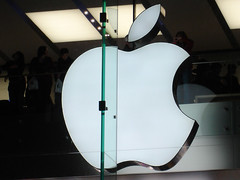Looks to me from this article like Samsung are going down the same competitive route as others before them in their battle with Apple. They’re looking to out-do them and to build a reputation and loyalty for themselves that replicates the following that Apple has.
Here’s the thing. As soon as any brand does this, there’s a very real risk that what it is actually doing is fighting with its perceived nemesis on their terms and therefore, subconciously or not, by their strengths. Because of the underlying references, Apple also becomes a focus and therefore, by implication, an authority. And all this within time and space that Samsung is paying for and looking to own. Unless they are very careful, there’s a real risk here that Apple could be allowed to Occupy Samsung’s marketing real estate – by Samsung itself.
After all, Apple is very good at being Apple. And their consumers love them for the brand they are.
It’s not smart brand strategy to address a strong brand competitor at their strongest points. If I were working for Samsung, in fact, I would be actively encouraging them to avoid any reference to their competitors. Rather, they need, in the words of Fleetwood Mac, to go their own way. The most powerful brand you can own and manage is one where you know and write the code – not one that takes its cues from where others are, or where you perceive them to be.
That’s not to say that any brand should ignore its competition. But rather, in my view, a brand like Samsung should use its competitive analysis to sort out things like the emotions that Apple and others don’t evoke and whether these represent opportunities for emotional equity.
The question is not, “what does Apple do well that we can do also?”. The question is “What can’t our competitors do that we can excel at?”
The real lesson that Samsung have taken and that they do need to pay attention to is that products are upgraded by repeat customers motivated as much by loyalty as technical introductions. Apple’s very good at that. But the way to beat them is not to look to emulate more of the same emotion.
In the tech world particularly, if Samsung is to have any hope of achieving its goal it will need to match technical innovation with emotional innovation.
Emotional innovation stems from finding what I term the “unexpected value”. It’s driven by this line of enquiry: “What is the most extraordinary feeling that people in this sector haven’t felt yet? And how will we deliver it to them?”
When you strategise and deliver a brand underpinned by unexpected value, you change the emotional landscape that you compete in and you sidestep the cluttered, increasingly emotive middle ground that your commoditising competitors are squabbling over. You also actively avoid reploughing the deeply owned and highly branded field of another. That’s how you build market leadership. That’s how you continue to lift brand equity. By owning and fuelling emotions that are increasingly and delightfully associated with you.
Thanks Todd for the heads-up.
More reading



